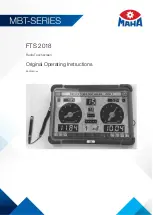
Test
Procedure
Before starting the test procedure, make sure the equipment is clean and in
good operating condition. Verify that a calibration curve is available for the
particular equipment to be used. If a calibration curve is not available, see
the “Creating a Calibration Curve” section on page 8 to construct one.
1. Obtain a sample of core, drilled cuttings, or other solids that are to be
analyzed. The sample should be dry and free of contaminants. Grind
the sample to 100 mesh or finer, using a mortar and pestle and a 100-
mesh sieve. If you do not know whether the sample has been dried,
heat it in an oven at 220°F (105°C) for 12 to 24 hours.
2. Weigh approximately 1.0 - 1.4 g of the sample to the nearest .001 g.
3. Load the test sample in the reactor cell.
a. Unscrew and remove the cell cap. Remove the acid cup from the
reaction cell.
b. Inspect the reaction cell and top. Make sure both are clean and dry.
c. Make sure the reaction cell o-ring on the top and the o-ring on the
bleed valve are in good condition. Use a light coating of vacuum
grease on the o-ring seals. Make sure all pipes or tubing connec-
tions are tight and do not leak.
d. Hold the reaction cell in a horizontal position and slide one piece of
paper and its sample to the bottom. Brush the paper with a small
brush to remove traces of the sample, then remove the paper.
e. Fill the acid cup with 20 mL 10% hydrochloric acid. Carefully place
the cup into the cell. Be careful not to spill the HCl or get any on
the bottom of the cup.
f.
Hand tighten the cell cap. Be careful not to splash any acid onto
the sample.
g. Open the bleed valve until the pressure reading is zero. Then close
the bleed valve tightly.
4. Turn the reaction cell back to vertical and start timing the test. This will
start the reaction between the HCl and the CaCO
3
.
OFITE, 11302 Steeplecrest Dr., Houston, TX 77065 USA / Tel: 832-320-7300 / Fax: 713-880-9886 / www.ofite.com
7

































